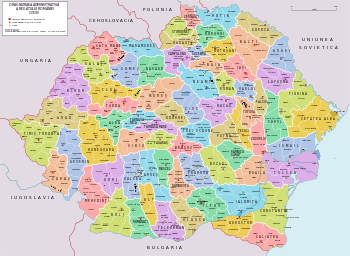Tutova County
| Județul Tutova | ||
|---|---|---|
| County (Județ) | ||
 The Tutova County Prefecture building from the interwar period, now a museum. | ||
| ||
 | ||
| Country |
| |
| Historic region | Moldavia | |
| Capital city (Reședință de județ) | Bârlad | |
| Established | 1925 | |
| Ceased to exist | Administrative reform of 1950 | |
| Area | ||
| • Total | 2,498 km2 (964 sq mi) | |
| Population (1930) | ||
| • Total | 144,821 | |
| • Density | 58/km2 (150/sq mi) | |
| Time zone | UTC+2 (EET) | |
| • Summer (DST) | UTC+3 (EEST) | |
Tutova County is one of the historic counties of Moldavia, Romania with the city of Bârlad as capital.
Geography
Tutova County covered 2,498 km2 and was located in the central-eastern part of Greater Romania, in the south-eastern part of Moldavia. Currently, the territory that comprised Tutova County is now included primarily at present in Vaslui County, with some of its southern portions in Bacău County and Galați County.[1] In the interwar period, the county neighbored Vaslui County to the north, Fălciu County to the northeast, Cahul County to the east, Covurlui County to the south, and Tecuci and Bacău counties to the west.
Administrative organization

Administratively, Tutova County was initially divided into three districts (plăși):[2]
- Plasa Alexandru Vlahuță, headquartered at Puiești
- Plasa Monolache Epureanu, headqartered at Murgeni
- Plasa Vasile Pârvan, headquartered at Grivița
Subsequently, after a reorganization, a fourth district was established:
- Plasa I.G. Duca, headquarted at Banca
Population
According to the census data of 1930, the county had a population of 144,821, 93.7% Romanians, 2.9% Jews, 2.6% Romanies, 0.2% Germans, as well as other minorities. In religious terms, the county population consisted of 96.5% Eastern Orthodox, 2.9% Jewish, 0.3% Roman Catholic, as well as other minorities.
Urban population
In 1930, the urban population of the county was 21,857 inhabitants, of which 81,9% were Romanians, 14,1% Jews, 0,8% Germans, as well as other minorities. From a religious point of view, the urban population was made up of 83.4% Eastern Orthodox, 14.2% Jewish, 1.0% Roman Catholic, as well as other minorities.
References
- ↑ Enciclopedia Romaniei. Vol. I-IV, Bucharest 1938, 1938 1943
- ↑ Portretul României Interbelice - Județul Tutova
External links
| Wikimedia Commons has media related to Interwar Tutova County. |
- (in Romanian) Tutova County on memoria.ro

